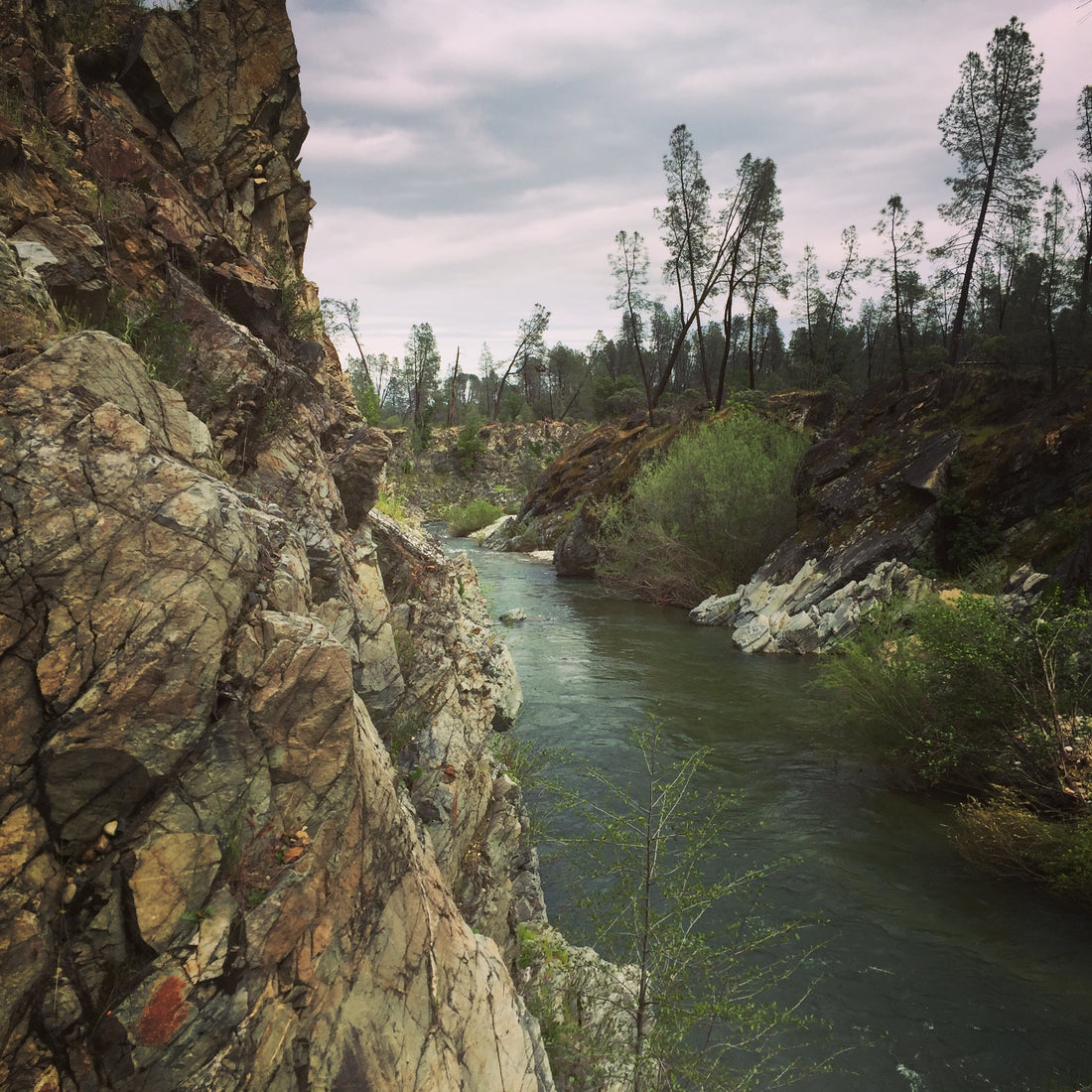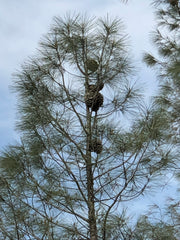
Native Plant: Pinus sabiniana (Gray Pine)
Share
If you’ve been hanging around these parts for a while you know my passion for the Pacific Northwest. I am in absolute awe of the abundance in nature. One of my new trees loves is the Gray Pine.

First discovered in the Umpqua country in Oregon, the Gray Pine is one of the most distinctive pine trees growing in the foothills of Southern Cascades, Sierra Nevada and surrounding the Central Valley. You can spot it easily by it’s greenish/gray airy foliage, and it’s peculiar growth form that looks like it’s about to fall over. Have you seen these trees?
 Gray Pine is also known by the names Foothill Pine, Ghost Pine, Bull Pine, and Nut Pine. In my first experience with the tree, it was introduced to me as the Digger Pine. However, I discovered that the once widely known name has actually fallen out of use due to the derogatory connotation to Native American Tribes. The tree was widely used by California Indian people who were collectively referred to as “root-diggers” because roots were, for the great portion of the year, their main subsistence. The term “Digger” as an ethnic label is now considered offensive. [See 1,2]. I’ll be referring to these pines as Gray Pine from now on.
Gray Pine is also known by the names Foothill Pine, Ghost Pine, Bull Pine, and Nut Pine. In my first experience with the tree, it was introduced to me as the Digger Pine. However, I discovered that the once widely known name has actually fallen out of use due to the derogatory connotation to Native American Tribes. The tree was widely used by California Indian people who were collectively referred to as “root-diggers” because roots were, for the great portion of the year, their main subsistence. The term “Digger” as an ethnic label is now considered offensive. [See 1,2]. I’ll be referring to these pines as Gray Pine from now on.
 Gray Pine is a little-appreciated species because it’s not the most useful or beautiful tree. But what I love about it is the way it defines our landscape with it’s wispy, angular growth. When I look out on the horizon and see the gray-green foliage and tell-tale whimsical twisted branches I feel at home. Here is how Willis Linn Jepson, one of California's early botanists, recorded the popular opinion of the gray pine in 1910, in The Silva of California: “Scarcely in any sense a beautiful tree, offering no comfort of shade to the inexperienced wayfarer who, dusty and sun-bitten, seeks its protection, scorned, too, by the lumbermen…”
Gray Pine is a little-appreciated species because it’s not the most useful or beautiful tree. But what I love about it is the way it defines our landscape with it’s wispy, angular growth. When I look out on the horizon and see the gray-green foliage and tell-tale whimsical twisted branches I feel at home. Here is how Willis Linn Jepson, one of California's early botanists, recorded the popular opinion of the gray pine in 1910, in The Silva of California: “Scarcely in any sense a beautiful tree, offering no comfort of shade to the inexperienced wayfarer who, dusty and sun-bitten, seeks its protection, scorned, too, by the lumbermen…”
 John Muir described this tree in the first chapter of My First Summer in the Sierra: “…the strange-looking Sabine pine (Pinus Sabiniana), which here forms small groves or is scattered among the blue oaks. The trunk divides at a height of fifteen or twenty feet into two or more stems, out leaning or nearly upright, with many straggling branches and long gray needles, casting but little shade. In general appearance, this tree looks more like a palm than a pine. The cones are about six or seven inches long, about five in diameter, very heavy, and last long after they fall, so that the ground beneath the trees is covered with them. They make fine resiny, light-giving camp-fires, next to ears of Indian corn the most beautiful fuel I've ever seen. The nuts, the Don tells me, are gathered in large quantities by the Digger Indians for food. They are about as large and hard-shelled as hazelnuts, --food and fire fit for the gods from the same fruit.” [See 3]
John Muir described this tree in the first chapter of My First Summer in the Sierra: “…the strange-looking Sabine pine (Pinus Sabiniana), which here forms small groves or is scattered among the blue oaks. The trunk divides at a height of fifteen or twenty feet into two or more stems, out leaning or nearly upright, with many straggling branches and long gray needles, casting but little shade. In general appearance, this tree looks more like a palm than a pine. The cones are about six or seven inches long, about five in diameter, very heavy, and last long after they fall, so that the ground beneath the trees is covered with them. They make fine resiny, light-giving camp-fires, next to ears of Indian corn the most beautiful fuel I've ever seen. The nuts, the Don tells me, are gathered in large quantities by the Digger Indians for food. They are about as large and hard-shelled as hazelnuts, --food and fire fit for the gods from the same fruit.” [See 3]
 If the appearance from afar doesn’t identify it you can also spot one by its long needles which grow in stiff bundles of three. The cones are another giveaway: they are super cool looking like a football with spikes all over it. Just watch for falling cones; they are the largest and heaviest in the pine family and can weigh up to 2 lbs! Gray pine impresses with its remarkable ability to grow out of rock outcrops, you can find them growing in extremely dry, sun-exposed areas. In its own right, the Gray Pine is a beautiful tree and I hope it continues to gain appreciation. What do you think of this tree? Love or hate it, leave your thoughts below.
If the appearance from afar doesn’t identify it you can also spot one by its long needles which grow in stiff bundles of three. The cones are another giveaway: they are super cool looking like a football with spikes all over it. Just watch for falling cones; they are the largest and heaviest in the pine family and can weigh up to 2 lbs! Gray pine impresses with its remarkable ability to grow out of rock outcrops, you can find them growing in extremely dry, sun-exposed areas. In its own right, the Gray Pine is a beautiful tree and I hope it continues to gain appreciation. What do you think of this tree? Love or hate it, leave your thoughts below.
P.S. To help achieve my mission of supporting this amazing region of the planet, I partner with One Tree Planted, a non-profit organization focused on global reforestation. Read more about my giving back efforts and how you can help.
P.S.S. If you love trees, read my article on the Legend of the Douglas Fir.
With much conifer love,

1. https://trees.stanford.edu/ENCYC/PINsab.htm
2. https://digitalassets.lib.berkeley.edu/anthpubs/ucb/text/ucp036-002.pdf
3.https://vault.sierraclub.org/john_muir_exhibit/writings/my_first_summer_in_the_sierra/

3 comments
Hi Naomi. Today I was in a nursery ( with all the Christmas tutorials) to search for pine cones. I collect them for years now ( also have a collection of oak leaves and oak acorns). Every year I try to find a Pinus coultery- cone , that is bigger than I have found earlier. So today I thought I found one which was bigger, but… when I was shaking the seeds out of it ( 9 seeds) I noticed they were big. So I looked to try to determine this pinecone it was not a coultery but Pinus sabiniana. The saminiana has bigger seeds than the coultery. Now I want to try and grow trees out of them. I have good connections with the Arboretum Trompenburg in Rotterdam ( The Netherlands). So you see , I don’t live in the USA, but near Rotterdam , in a village called Krimpen aan de Lek. ( If you look on Google maps you will see (The Netherllands) Krimpen aan de Lek. The Lek is a river, and at the opposite side of the river you can see the 19 antique Windmills ( World Heritage) for what Holland is famous for ! Greetings from Holland. I loved your stories of the Pines and also love the Douglas Fir legend. Bless you and have nice Christmas seasons. Bye Annemarie.
Is it strange that I can almost smell the trees and brush in your photos? I adore the PNW. there is a stillness there that is unmatched anywhere else in the world. It is truly a magical place!
Growing up I used to take long walks and going to parks surrounded by these Pines, I never took a moment to learn more or read about them, thank you so much for sharing this!